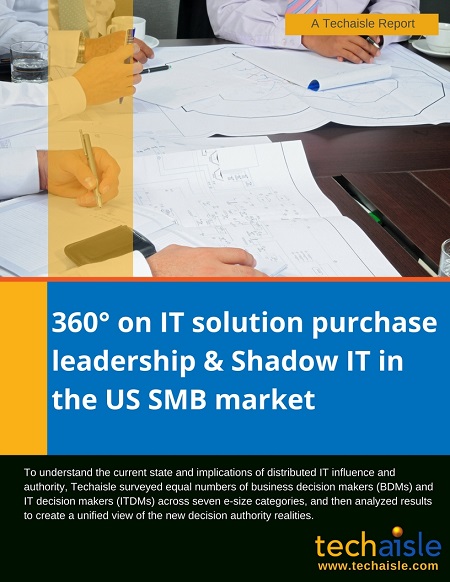360° on IT solution purchase leadership & Shadow IT in US SMBs

Techaisle Reports are available for a fee, either individually or as part of Techaisle's annual subscription services. Detailed table of contents of the report for review can be downloaded below.
A large scale survey of BDMs & ITDMs within US SMBs and midmarket firms to understand who has more influence in IT purchase decisions and in which IT solution areas & why.
Change is a constant in the IT industry. Management struggles to maintain an understanding of (much less integration across) new technology areas like IoT, Big Data, analytics/BI, mobility and cloud. We continuously see advances in each of these areas, and in their underlying platform hardware and software – and we are aware that IT professionals are scrambling to stretch limited budgets to meet seemingly-limitless IT/business requirements, striving to deliver predictable, secure systems that respond to the increasingly-varied needs of their business users and competitive environments.
Yet despite the constant evolution of technology itself, it can be argued that the biggest change in the IT landscape is not a technology or set of technologies but the evolution of the decision making unit (DMU) around IT. Up until a decade or so ago, buyers and sellers alike could assume that a limited number of staff members would take responsibility for researching, evaluating, acquiring and deploying technology. The specific people comprising the DMU would change from product to product, but its characteristics stayed relatively static: typically, the DMU included an average of 3-4 individuals, all of whom were decision makers based within the IT department (ITDMs), and all of whom depended on a relatively narrowly-defined set of inputs (IT trade journals, trade shows, consultants, etc.) for information.
Today, the DMU is much bigger, much more diverse, much more difficult to inform, and can be much slower to take action. Business decision makers (BDMs) are an intrinsic force within DMUs in most organizations, and are the primary decision makers in some high-growth areas. These BDMs have different objectives for technology, different perspectives on adoption drivers and impediments, and tend to be influenced by different information sources. The resulting diffusion in responsibility/authority and information channels has created an environment where buyers and sellers struggle to develop the cohesion needed to promote or embrace new IT/business capabilities within existing IT and business process structures.
To help shed light on this issue, Techaisle conducted a unique survey of US SMB organizations. To understand the current state and implications of distributed IT influence and authority, we surveyed roughly equal numbers of business decision makers (BDMs) and IT decision makers (ITDMs) across seven e-size categories, and then analyzed results to create a unified view of the new decision authority realities.
Brief Table of Contents is given below. For more details & list of figures please download the Table of Contents document.
- Executive Summary
- The tole of BDMs (Line-of-business executives) in the SMB IT solution adoption cycle
- ITDMs vs. BDMs: the balance of purchase authority
- Blurring the IT/business divide
- Shadow IT Spending within US SMBs
- IT solution leadership
- Messaging options & requirements
- BDM involvement in IT operations
- Concluding observations

- Report and analysis is based on detailed surveys with US midmarket firms (100-999 employees) and small businesses (1-99 employees). Respondents were key decision makers responsible - both from IT and non-IT. In most businesses, more than one interview was conducted to understand the business and IT perspectives for the same IT solution purchase
- Total number of businesses surveyed in the study = 900
- Sampling quota fixed by employee size categories: 1-9, 10-19, 20-49, 50-99, 100-249, 250-499, 500-999
List Price: US$4500

- Word/PDF Report
- 2 hours of inquiry on data
List Price: US$4500

